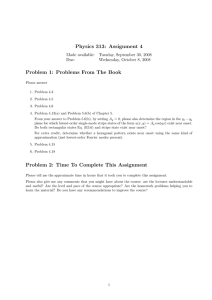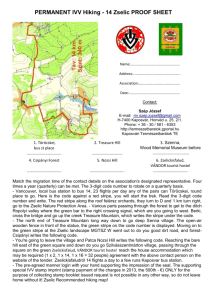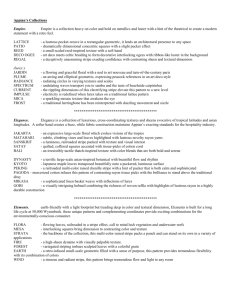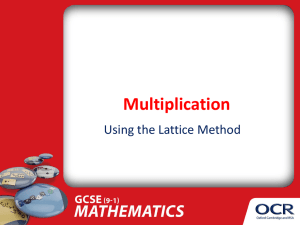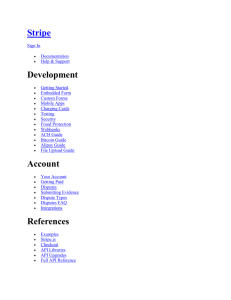Theory of a Continuous Stripe Melting Transition in a Two-
advertisement
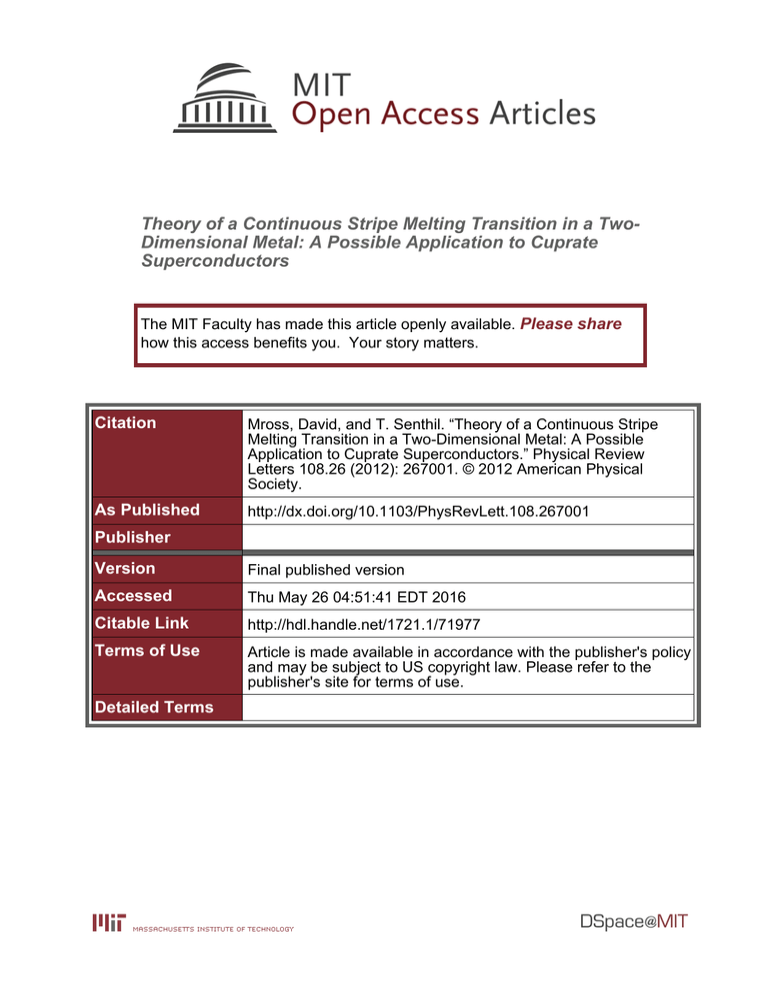
Theory of a Continuous Stripe Melting Transition in a TwoDimensional Metal: A Possible Application to Cuprate Superconductors The MIT Faculty has made this article openly available. Please share how this access benefits you. Your story matters. Citation Mross, David, and T. Senthil. “Theory of a Continuous Stripe Melting Transition in a Two-Dimensional Metal: A Possible Application to Cuprate Superconductors.” Physical Review Letters 108.26 (2012): 267001. © 2012 American Physical Society. As Published http://dx.doi.org/10.1103/PhysRevLett.108.267001 Publisher Version Final published version Accessed Thu May 26 04:51:41 EDT 2016 Citable Link http://hdl.handle.net/1721.1/71977 Terms of Use Article is made available in accordance with the publisher's policy and may be subject to US copyright law. Please refer to the publisher's site for terms of use. Detailed Terms PRL 108, 267001 (2012) week ending 29 JUNE 2012 PHYSICAL REVIEW LETTERS Theory of a Continuous Stripe Melting Transition in a Two-Dimensional Metal: A Possible Application to Cuprate Superconductors David F. Mross and T. Senthil Department of Physics, Massachusetts Institute of Technology, Cambridge, Massachusetts 02139, USA (Received 24 January 2012; published 26 June 2012) We construct a theory of continuous stripe melting quantum phase transitions in two-dimensional metals and the associated Fermi surface reconstruction. Such phase transitions are strongly coupled but yet theoretically tractable in situations where the stripe ordering is destroyed by proliferating doubled dislocations of the charge stripe order. The resulting non-Landau quantum critical point has strong stripe fluctuations which we show decouple dynamically from the Fermi surface even though static stripe ordering reconstructs the Fermi surface. We discuss connections to various stripe phenomena in the cuprates. We point out several puzzling aspects of old experimental results [G. Aeppli et al., Science 278, 1432 (1997)] on singular stripe fluctuations in the cuprates, and provide a possible explanation within our theory. These results may thus have been the first observation of non-Landau quantum criticality in an experiment. DOI: 10.1103/PhysRevLett.108.267001 PACS numbers: 74.72.h, 74.25.Ha, 74.40.Kb Over the last 15 years it has become clear that a tendency to charge and/or spin stripe order is remarkably common in almost all families of underdoped cuprates [1]. Recently the idea that quantum criticality associated with the onset of stripe order and associated Fermi surface reconstruction may be responsible for the non-Fermi liquid physics seen around optimal doping in the normal state has become popular [2]. Despite this strong motivation there is very little theoretical understanding of continuous stripe ordering transitions in a metallic environment. In a weakly interacting metal the stripe ordering transition can be formulated by coupling the fluctuating charge or spin stripe order parameter to the Fermi surface. Recent work shows that the stripe fluctuations are strongly coupled to the Fermi surface at low energies and there is no controlled description [3,4] so that the theory is poorly understood. For the cuprates these difficulties are perhaps not directly bothersome since the weak coupling description of the stripe fluctuations is in any case unlikely to be the right starting point. Rather, as advocated in Ref. [5], it may be more fruitful to take a strong coupling point of view and regard the phase transition as a quantum melting of stripe order driven by proliferation of topological defects. A theory of continuous quantum melting phase transitions of stripe order in a metal is not currently available and will be provided in this Letter. On the experimental side surprisingly little is known about the possible presence of quantum critical stripe fluctuations around optimal doping. An important and well known exception is a neutron scattering study of near optimal La2-x Srx CuO4 (LSCO) by Aeppli et al [6]. As we discuss below these results paint a rather intriguing picture of the singular stripe fluctuations. Reference [6] measured the spin fluctuation spectrum in La1:85 Sr0:14 CuO4 over a wide range of frequency and tem0031-9007=12=108(26)=267001(5) perature near the spin stripe ordering wave vector. The width of the incommensurate peak (which is the inverse pffiffiffiffiffiffiffiffiffiffiffiffiffiffiffiffiffiffi correlation length) increases approximately as T 2 þ !2 as expected of a strongly coupled quantum critical point (QCP) with dynamical critical exponent z ¼ 1. We would like to point out that z ¼ 1 is rather surprising for a metal like near optimal LSCO. The spin stripe ordering wave vector clearly connects two points of the electronic Fermi surface measured by photoemission. In any metal that has reasonably sharp quasiparticlelike peaks (certainly in a Landau Fermi liquid which the metallic state is of course not but also in a marginal Fermi liquid and other non-Fermi liquid models [7] which it might be) the stripe fluctuations will be Landau damped. Usually this Landau damping is strongly relevant and leads to a renormalization of z away from 1. Thus the observation of z ¼ 1 is significant. It suggests that either the usual Landau damping mechanism is absent in the normal state or that the Landau damping is present but does not affect the quantum critical fluctuations. The latter possibility is a strong hint of a quantum phase transition beyond the Landau-Ginzburg-Wilson paradigm. Further evidence for a non-Landau QCP comes from measurements of the height of the peak of the incommensurate spin fluctuations. The imaginary part of the dynamic ð!;TÞ spin susceptibility satisfies P00 ! T 1:940:06 at low frequency. From a standard scaling argument [8] it follows that the anomalous exponent 1:06 for the critical spin fluctuations. Such a large value of is uncommon for Landau QCPs but is typical for non-Landau QCPs [9–15]. The absence of Landau damping effects is consistent with other observations of magnetic excitations in underdoped cuprates [16]. Pertinent to this is whether a pseudogap is present in the angle-resolved photoemission spectra 267001-1 Ó 2012 American Physical Society PRL 108, 267001 (2012) week ending 29 JUNE 2012 PHYSICAL REVIEW LETTERS FIG. 1. Schematic zero-temperature phase diagram close to the multicritical point X. The dashed line is parametrized by g. (ARPES) that partially gaps out the Fermi surface. If the hot spots lie in pseudogapped portions of the Fermi surface no Landau damping may be expected. At doping x ¼ 0:15 LSCO has a pseudogap in the ARPES spectrum which opens below 150 K [17]. The neutron data of Ref. [6] extend from 300 to 35 K and evolves smoothly without noticing the opening of the pseudogap. Thus it appears as though the critical stripe fluctuations are indifferent to the fate of the Fermi surface. In this Letter we construct a theory of continuous stripe melting quantum phase transitions in a metal and use it to propose an explanation of the puzzles pointed above. For definiteness we consider an orthorhombic crystal (tetragonal symmetry will be analyzed elsewhere [7]) with unidirectional stripe order at some wave vector Q. The spin at site r varies as ~ þ c:c:; S~ ¼ eiQr M (1) ~ is a complex three-component vector. This kind where M of spin order will induce charge order at 2Q, r e2iQr c þ c:c:; (2) ~ 2 . For strong coupling stripe melting transiwith c M tions it is natural to expect that the spin stripe order will melt through two phase transitions—first the spin order goes away while charge stripe order persists (i.e., translation symmetry remains broken) followed by a second transition where the charge stripe also melts. Despite the presence of two distinct quantum phase transitions, the somewhat higher-T physics will be controlled by a ‘‘mother’’ multicritical point where spin and charge stripe order simultaneously melt (see Fig. 2). We postulate that the temperature regime probed in the experiments of Ref. [6] is controlled by such a multicritical stripe melting fixed point. We will provide a theory of the critical point where the charge stripe order melts, and the multicritical point where spin and charge stripe order simultaneously melt. Melting of stripe order occurs through proliferation of topological defects. We focus on dislocations in the charge stripe order parameter. To understand the nature of these ~ may be dislocations we note that the complex vector M written ~ ¼ eis N~ M (3) FIG. 2. Schematic finite temperature phase diagram as a function of g (see Fig. 1). The spin order vanishes first at gs while the charge order persists up to gc . with N~ a real three-component vector. The charge stripe order parameter c may then be written as c ¼ eic (4) with c ¼ 2s . Stripe dislocations correspond to vortices in c . If c winds by an odd multiple of 2, then s winds by an odd multiple of . Single valuedness of the spin stripe order parameter implies that N~ also changes sign on going around such a dislocation. If c winds by an even multiple of 2, N~ is single valued. Thus the spin order is frustrated around odd strength dislocations but not for even strength dislocations (see Fig. 3). Formally Eq. (3) contains ~ a Z2 gauge redundancy associated with letting N~ ! N, s ! s þ at each lattice site. Odd strength dislocations are bound to vortices of the Z2 gauge field. Frustration of spin order at a single dislocation contributes a term to its energy that raises it compared to the energy of doubled dislocations [18]. This can occur even if there is no long-range spin order but substantial shortrange spin stripe correlations. If this contribution dominates then it is energetically favorable to proliferate doubled rather than single dislocations. The corresponding stripe liquid phase was first envisaged by Zaanen and coworkers [19] and studied further in Refs. [20–22]. It is strictly distinct (meaning it cannot be smoothly connected to) the usual weakly interacting Fermi liquid. However the FIG. 3. (a) Charge order at 2Q is frequently accompanied by spin order at Q. In this case the spin-order parameter undergoes a sign change from one charge stripe to the next. (b) Single dislocations in the charge stripes are bound to half dislocations for the spin order, leading to frustration. (c) Double dislocations in the charge stripes avoid frustration. 267001-2 PRL 108, 267001 (2012) distinction is extremely subtle and may easily escape detection by any conventional experimental probe. When single stripe dislocations have finite core energy, at low energies both N~ and b eis become well defined. We may envisage four different phases (see Fig. 1). The ~ 0, while a phase spin stripe ordered phase has hbi, hNi with charge stripe but no spin stripe order has hbi 0, ~ ¼ 0. A phase with hbi ¼ 0, hNi ~ 0 preserves transhNi lational and time reversal symmetries but breaks spin rotational symmetry by developing a spontaneous spin quadrupole moment Qab ¼ Na Nb 13 N~ 2 ab (such a phase ~ ¼0 is also called a spin nematic). Finally hbi ¼ 0, hNi describes a phase with no broken symmetries but a fractionalization of the stripe order parameter. In the presence of itinerant fermions this latter phase has a conventional large Fermi surface while the striped phases with hbi 0 will have their Fermi surfaces reconstructed by the stripe order. ~ tÞ describes the local displacement of The phase c ðx; the charge stripes in the x^ direction at time t (we take the ^ and its conjugate variable generates stripes to run along y) ^ An effective model that translations of the stripes along x. describes charge stripe fluctuations takes the form of a quantum XY model for the phase c , where the analog of a chemical potential term that couples linearly to the conjugate momentum is prohibited as it is odd under both lattice reflection about y^ and time reversal. We now discuss the charge stripe melting transition, initially ignoring the coupling of the stripe order parameter to the Fermi surface, and the pinning of the stripe order parameter by the underlying crystalline lattice. As the Z2 gauge flux is gapped everywhere in the phase diagram we may safely ignore it to study low energy properties. A ‘‘soft-spin’’ effective field theory that captures the universal properties of all the phase transitions may then be written down in terms of the b, N~ fields, Z ~ ¼ dd2 xLb þ LN þ LbN ; S½b; N (5) 1 j@ bj2 þ rb jbj2 þ ub jbj4 ; v2c (6) 1 ~ 2 þ uN jNj ~ 4; ~ 2 þ rN jNj j@ Nj v2s (7) Lb ¼ jrbj2 þ ~ 2þ LN ¼ jrNj week ending 29 JUNE 2012 PHYSICAL REVIEW LETTERS ~ 2: LbN ¼ vjbj2 jNj (8) In the spin disordered phases the N~ field is gapped and may be integrated out. Thus the charge stripe melting is described as an XY condensation transition of the b field. However the physical stripe order parameter c ¼ b2 is a composite of the fundamental XY field b. Thus the stripe order parameter has critical power law correlations with a large anomalous dimension c 1:49 [23]. This makes the universality class of the transition fundamentally different (but simply derivable) from the ordinary XY universality class. Indeed the only physical operators at this transition are those that are invariant under the local Z2 gauge transformation. For these reasons this transition has been dubbed the XY transition in the prior literature [14,15,24]. Including the presence of a metallic Fermi surface leads, in the stripe ordered phase, to a term X c cykþQ ck þ H:c: (9) k in the conduction electron Hamiltonian which will reconstruct the Fermi surface if the stripe ordering wave vector connects two points of the Fermi surface. In this case at the critical point or in the stripe melted phase this coupling will lead to the standard Landau damping of the stripe fluctuations, Z d d!d2 qj!jj c ðq; !Þj2 : (10) The relevance or irrelevance of this term (which is a longranged imaginary time interaction) at the stripe melting XY critical point is readily ascertained by power counting. Under a renormalization group transformation x ! x0 ¼ xs , 1þ ! 0 ¼ s , we have c ! c 0 ¼ s c with ¼ 2 c . This implies 0d ¼ d s1c : (11) As c > 1 at the XY fixed point, the Landau damping of the critical stripe fluctuations is irrelevant. The energy density associated with the stripe fluctuations can also couple to the gapless modes of the Fermi surface. As argued in Ref. [22] these are irrelevant so long as the correlation length exponent XY > 23 , which is the case at the XY fixed point. Pinning of the stripe order by the underlying lattice is important for commensurate stripes such as the period-4 charge stripe. At the critical point this leads to eightfold anisotropy for the b field which is known to be strongly irrelevant at the 2 þ 1-D XY fixed point. Thus the XY stripe melting critical point survives unmodified by either the coupling to the lattice or to the electronic Fermi surface. On tuning through this transition the Fermi surface undergoes a reconstruction, through the coupling of the stripe order parameter to the conduction electrons as described above in Eq. (9). A simple power counting argument [7] shows that the gap FS that opens at the hot spot scales with the distance to the critical point as FS jjðc þ1Þ=2 . The scale of stripe ordering, i.e., the zero-T stiffness of phase fluctuations in the ordered phase, is Stripe jjz . As c þ 1 > 2z, FS is parametrically smaller than Stripe . Now we turn our attention to the multicritical point where spin and charge stripe order melt simultaneously, 267001-3 PRL 108, 267001 (2012) i.e., both b and N~ are critical, ignoring initially both the lattice pinning and the coupling to the Fermi surface. When v ¼ 0 the multicritical point where b and N~ both go critical is described by a decoupled Oð3Þ Oð2Þ fixed point where a small v term is an irrelevant perturbation [25]; thus, there is a finite basin of attraction. At this decoupled fixed point the considerations above show that the coupling of the Fermi surface to the charge stripe order parameter b (and lattice pinning for commensurate period-4 stripes) is irrelevant. What about the Fermi ~ First the coupling of the breathing surface coupling to N? mode of the Fermi surface to the energy density of N~ fluctuations is irrelevant as Oð3Þ > 23 . Second N~ itself cannot directly couple to the particle-hole continuum at the hot spots of the Fermi surface as it is not gauge invariant. Rather what couples is the physical spin stripe ~ ¼ bN. ~ The correlations of M ~ in spaceorder parameter M ~ time factorize into a product of the b and N correlators at the decoupled fixed point, ~ ~ 0Þi hMðx; Þ Mð0; week ending 29 JUNE 2012 PHYSICAL REVIEW LETTERS 1 : ðx2 þ v2c 2 Þð1þb Þ=2 ðx2 þ v2s 2 Þð1þN Þ=2 (12) ~ correlations have anomalous dimenIt follows that the M sion M ¼ 1 þ N þ b , where N;b are the order parameter anomalous dimensions at the Oð3Þ, XY fixed ~ to the Fermi surface points respectively. The coupling of M particle-hole continuum will generate a Landau damping term, Z ~ 2: d2 qd!j!jjMj (13) By the same argument as below Eq. (10), this is irrelevant so long as M > 1 which is clearly satisfied. Another gauge invariant operator is the spin quadrupole operator Qab ¼ Na Nb 13 N~ 2 ab which has scaling dimension 1þ Q ¼ 2 Q with Q 1:43 [23]. This has slow correlations near zero wave vector and so couples to the entire Fermi surface. However the coupling to the Fermi surface is only through four fermion terms. Consequently the damping of the Qab fluctuations by the Fermi surface is weak [7], j!j3 jQj2 , and is irrelevant. We are thus left with the remarkable situation that the decoupled multicritical point survives the inclusion of the coupling to the Fermi surface (and lattice pinning). Clearly finite-T correlations will satisfy !=T scaling, with the dynamical critical exponent z ¼ 1 despite the presence of the particle-hole excitations of the metal. Finally the structure of the critical spin stripe correlations determines the behavior of the dynamical spin susceptibility. A standard scaling argument shows that the temperature dependence ð!;TÞ of P00 ! measured in the experiments of Ref. [6] goes as 1 . Using b 0:04 and N 0:04 (see, e.g., T 3M ð!;TÞ 1 Ref. [26]) we find P00 ! T 1:92 in excellent agreement with the data of Ref. [6]. Thus our proposed theory resolves the puzzles posed by the singular stripe fluctuation spectrum. Several concrete predictions also follow from the theory for future experiments. First, the charge stripe order parameter will exhibit quantum critical scaling with an anomalous dimension c 1:49. Second, so will the spin quadrupole (i.e., spin nematic) order with anomalous dimension Q 1:43. Further, for g & gc , there are two (parametrically) different energy scales Stripe FS . The transition temperature for stripe ordering is set by Stripe , but in transport measurements the reconstructed zero-T Fermi-surface is only revealed for T FS . A different qualitatively nontrivial prediction of our theory is the possible existence of the stripe fractionalized metal phase in the overdoped side of the cuprate phase diagram. This phase has a conventional large Fermi surface of electronic quasiparticles and so can be easily mistaken for an ordinary Fermi liquid. The distinctions with the Fermi liquid are very subtle—the soft stripe fluctuations have a different character from a Fermi liquid, and there are stable gapped topological defects associated with the remnants of uncondensed single dislocations of the charge stripe order. Such gapped excitations do not modify the low-energy properties of the bulk system, making it very difficult to directly detect this phase. It may thus be more fruitful to focus on properties close to the phase transition into the stripe-ordered phase, which as we emphasized above has very unique features. In addition to this transition, at even higher doping, there will be a further quantum phase transition into the Fermi liquid, which was studied in Ref. [22]. Let us conclude by reiterating our main results. We constructed a non-Landau theory of a continuous charge stripe melting transition in a two-dimensional metal and discussed various puzzles posed by the existing well known experimental observation [6] of singular spin stripe fluctuations in a near optimal cuprate metal. We proposed an explanation of these puzzles in terms of a non-Landau multicritical quantum stripe melting transition where the spin and charge stripe orders simultaneously melt. Thus Ref. [6] may have been the first experimental observation of non-Landau quantum criticality. We outlined a number of predictions for future experiments. For the stripe melting transitions discussed here the decoupling of the critical fluctuations from the Fermi surface means that the Landau quasiparticle is preserved all over the Fermi surface (see Ref. [14] for a calculation in a different context). Thus this kind of stripe melting transition cannot explain most of the observed non-Fermi liquid single particle physics in the cuprates. While some other (possibly independent) mechanism is necessary for the destruction of the Landau Fermi liquid, our theory provides an explanation 267001-4 PRL 108, 267001 (2012) PHYSICAL REVIEW LETTERS for observations related to the stripe fluctuations and subsequent reconstruction of the Fermi surface. We thank Eduardo Fradkin, Steve Kivelson, Young Lee, and Stephen Hayden for useful discussions. T. S. was supported by NSF Grant No. DMR-1005434. [1] For recent reviews, see, e.g., S. A. Kivelson, I. P. Bindloss, E. Fradkin, V. Oganesyan, J. M. Tranquada, A. Kapitulnik, and C. Howald, Rev. Mod. Phys. 75, 1201 (2003); M. Vojta, Adv. Phys. 58, 699 (2009). [2] L. Taillefer, Ann. Rev. Condens. Matter Phys. 1, 51 (2010). [3] A. Abanov and A. V. Chubukov, Phys. Rev. Lett. 84, 5608 (2000); 93, 255702 (2004). [4] M. A. Metlitski and S. Sachdev, Phys. Rev. B 82, 075128 (2010). [5] S. A. Kivelson, E. Fradkin, and V. J. Emery, Nature (London) 393, 550 (1998). [6] G. Aeppli, T. E. Mason, S. M. Hayden, H. A. Mook, and J. Kulda, Science 278, 1432 (1997). [7] David F. Mross and T. Senthil (unpublished). [8] In the quantum critical region, the imaginary part of the 1 Fð!T ; jkj Þ, dynamical susceptibility scales as 00 T ð2Þ=z T 1=z where k is the deviation in momentum from the ordering wave vector. Thus the peak height at zero frequency, 00 T ð2þzÞ=z . From the experimental lim!!0 ðk¼0;!;TÞ ! observations this peak height T 1:94 and z ¼ 1; it then follows that ¼ 1:06. [9] T. Senthil, A. Vishwanath, L. Balents, S. Sachdev, and M. P. A. Fisher, Science 303, 1490 (2004). [10] A. V. Chubukov, T. Senthil, and S. Sachdev, Phys. Rev. Lett. 72, 2089 (1994). [11] S. V. Isakov, T. Senthil, and Y. B. Kim, Phys. Rev. B 72, 174417 (2005). week ending 29 JUNE 2012 [12] O. I. Motrunich and A. Vishwanath, Phys. Rev. B 70, 075104 (2004). [13] A. W. Sandvik, Phys. Rev. Lett. 98, 227202 (2007). [14] T. Grover and T. Senthil, Phys. Rev. B 81, 205102 (2010). [15] S. V. Isakov, R. G. Melko, and M. B. Hastings, Science 335, 193 (2012). [16] J. M. Tranquada, in Handbook of High-Temperature Superconductivity (Springer, New York, 2007). [17] T. Yoshida, M. Hashimoto, S. Ideta, A. Fujimori, K. Tanaka, N. Mannella, Z. Hussain, Z.-X. Shen, M. Kubota, K. Ono, S. Komiya, Y. Ando, H. Eisaki, and S. Uchida, Phys. Rev. Lett. 103, 037004 (2009). [18] We thank Steve Kivelson for pointing this out to us. Thermal melting of stripes by proliferating double dislocations was studied in Refs. [27–29]. [19] J. Zaanen, O. Y. Osman, H. V. Kruis, Z. Nussinov, and J. Tworzydlo, Philos. Mag. B 81, 1485 (2001). [20] Z. Nussinov, and J. Zaanen, J. Phys. IV (France) 12, 245 (2002). [21] Y. Zhang, E. Demler, and S. Sachdev, Phys. Rev. B 66, 094501 (2002). [22] S. Sachdev and T. Morinari, Phys. Rev. B 66, 235117 (2002). [23] H. G. Ballesteros, L. A. Fernandez, V. Martin-Mayor, and A. Munoz-Sudupe, Phys. Lett. B 387, 125 (1996). [24] T. Senthil and M. P. A. Fisher, Phys. Rev. B 62, 7850 (2000). [25] A. Aharony, Phys. Rev. Lett. 88, 059703 (2002). [26] M. Campostrini, M. Hasenbusch, A. Pelissetto, P. Rossi, and E. Vicari, Phys. Rev. B 63, 214503 (2001); 65, 144520 (2002). [27] Frank Krüger and Stefan Scheidl, Phys. Rev. Lett. 89, 095701 (2002). [28] E. Berg, E. Fradkin, and S. A. Kivelson, Nature Phys. 5, 830 (2009). [29] Leo Radzihovsky and Ashvin Vishwanath, Phys. Rev. Lett. 103, 010404 (2009). 267001-5
